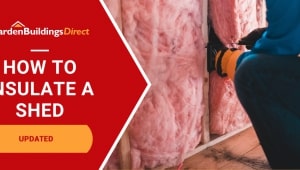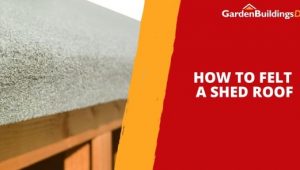Jump to:
Dogs deserve a space that feels like home, and you can make that happen with what you already have. Turning a shed into a dog house is one way to do it. This gives them a dry, shaded, and comfortable place to rest outdoors.
If you’re planning to shelter dogs as a business, you might be best off with a purpose-built brick shed, which might need to pass animal safety checks. But for your own personal use, here’s how you can dedicate your shed to your furry friend.
Best Ways for Converting Shed into Dog House
It’s important to note that making structural modifications to your shed could void the manufacturer’s warranty.
The frame is already there. All you need are a few small upgrades and additions, such as:
Welcome more natural light and air inside the shed dog house
For your furry companions, turning the shed into their garden home is a real upgrade. The space is bigger, so the inside should feel less like a box and more like a spot they want to hang out in.
A couple of low windows would let them watch outside and still keep an eye on the front or back gate. Or, try a roof vent if you want airflow without altering the walls. A small screened flap near a window or door is also helpful during the summer.
This is a great starting point that doesn’t need major changes to the shed. And it works even better if the structure already has windows.
Shed insulation for year-round fun and play
One thing many wooden sheds lack is built-in insulation. Fortunately, it’s easy enough to add yourself, especially if the space isn’t too big. Foam boards or insulation rolls between the walls should do it (don’t use fibreglass). Cover them with plywood panels, and your dog will feel much more comfortable in summer and winter.
You can always add extras like a draft stopper at the door. A low-wattage heater or heated mat is also useful for colder months, but keep cables away from dogs’ teeth — consider mounting it on the wall. For safety, use the space mainly after their afternoon play. A shed is probably not suitable for sheltering dogs overnight unless it’s ventilated and insulated by a professional.
Furnish the space as if it’s a house
Treat the shed like a little house for your dog. If it’s roomy, split it into areas for sleeping, eating, and playing. For instance, one corner for a raised bed. Another for food and water with a waterproof mat underneath, and a small area with toys or a scratching post.
Don’t worry if it’s small. A bed, a stacked or wall-mounted feeder or bowls, and a basket of toys they can pull out when they want to play does the job.
If possible, cover the floorboards with rubber mats or vinyl flooring, both of which are easy to clean.
Lift their nap spot with a raised bed
Floorboards get cold, and a mattress on the floor isn’t always enough. Raising their bed with a wooden pallet, a low crate, or a small platform is a straightforward DIY project.
You don’t even need foam; a thick blanket or washable cushion makes a comfy spot on its own. Then place their new nap spot near a window to let in fresh air.
Invest in an automatic water station
What we like about this is that it gives dogs fresh water throughout the day without you hovering. You can find one that sits on the floor or mounts on the wall, whichever works best for your shed dog house layout.
The trick is to put a small tray underneath to catch drips, or line the area with a mat that’s easy to wipe down. Place it away from the bed so your dog can drink without splashing onto their nap spot.
Might as well get a treat-dispensing toys
Besides their chew and plush toys, this is a real treat for them—literally. It’s a toy and a feeder at the same time. Stuff it with dry kibble, small treats, or even a bit of peanut butter (xylitol-free) and watch your dog figure out how to get the goodies.
The best part is it keeps them busy for longer stretches, which is handy if you’re stepping out or working in the garden. Some come as balls that roll and release treats, others as puzzle boxes. Switch between a few different toys to keep your dog interested and challenged each day.
Build a safe entry point
When it comes to doors, do a little bit of Handy Manny-style tinkering. A split or stable-style door is fantastic. The top half opens, letting in daylight and air, while the bottom part stays closed—no route for escaping!
Then again, don’t make your furry friends feel like they’re boxed in. Say, they like to hang out at the entrance to their shed. Why not add a small gated porch or mesh run outside? Muddy paws can still be a problem, but a roof overhang or small canopy can keep the doorway dry.
Round-up
These are just a few ideas for turning garden storage into a shed dog house. We’ll leave the cleaning and preparation to you, but we hope this list helps you make it happen. Remember to keep the space clean and organised for your dog’s safety.
Get more inspirations here: Garden Shed Retreat for Pets: Considerations + Tips





